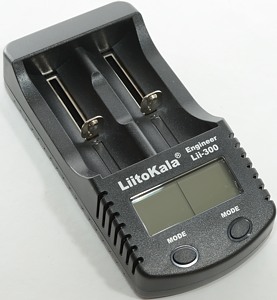
photo stolen from HKJ
Impressions
The reason for this review is to highlight daily use thoughts and not redo the technical tests already thoroughly described.
In my long quest to find a fully charging charger (with various devices that charge to 4.04-4.15V) i purchased this charger, based on its features and the the thorough tests conducted by HKJ (the go to guy for all hardware). Took over a month to receive it, and upon charging the first battery it read as 4.2V.
Then a series of coincidences struck, the next battery seemed to overheat, it was too hot to hold, read as 125 mR on the charger, and the multimeter read 4.42V! I drained it in a flashlight and charged another battery, this one also overheated and read 4.38V and 125mR (quite the coincidence on internal resistance). I assumed the charger was bad, so with some investigation i discovered the multi meter was reading high because of a low battery, my backup multimeter is reading low and high depending on the settings used (2V and 20V), both batteries read 125mR which seems to be the highest the charger can display (but is not described anywhere), and using non laptop pull batteries read 60mR which charged successfully and read 4.2V.
I always check my batteries temperature while charging by touch since no li ion charger i own has high temperature shutoff, and this sometimes resets this charger which can be frustrating because the battery may have been almost charged and its starting again, and you lose count of how many mAH has been put in it. Also a capacity test may have to be restarted ![]()
Pros
Has internal resistance testing
The display tells you how far along the charging is
Capacity testing is very illuminating
Cons
Internal resistance is not in milliohm and seems to top out at 125 mR which i have no idea how to convert to ohms. Also it starts testing as soon as the battery is inserted, if your still orienting the battery it artificially raises the tested value.
Batteries heat up during discharge testing, probably because the internal resistor(s) that dissipate voltage is thermally connected to the terminals and/or case adjacent to the batteries
Suggested improvements
Add the option to keep the backlight on
Add the ability to autoscroll trough the data (mAH, resistance, charge time)
Wait a few seconds after insertion to start the internal resistance test
Test the internal resistance in milliohm not a proprietary unit
Don’t have an undeclared maximum internal resistance value
Suggested new features
Add an indication the charger has switched to CV mode
Add a temperature reading/display and add high temp shutoff